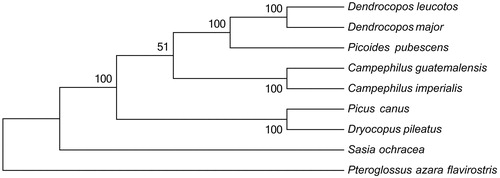Abstract
The grey-headed woodpecker (Picus canus) is one species of family Picidae. In this study, the complete mitochondrial genome of the grey-headed woodpecker was determined and annotated for the first time. It is a circular molecule of 17,103 bp in size and contains 13 protein-coding genes (PCGs), 2 rRNA genes (12S and 16S), 22 tRNA genes (tRNAs), and 2 control regions (D-loop regions). The total base composition is 28.13% for A, 34.57% for C, 13.87% for G, and 23.43% for T, respectively. In addition, phylogenetic analysis was carried out according to the DNA data of 13 PCGs using the neighbour-joining method. The complete mitogenome of grey-headed woodpecker will play an important role in population genetics and phylogenetic studies of the species in the future.
The mitochondrial genome in mammals is a circular and double-stranded DNA molecule with approximately 14.5–19.5 kb in size and codes for 37 genes (Du Toit et al. Citation2014). The DNA sequences from mitochondrial genome have played important roles in studies related to phylogenetic relation, genetic diversity, and evolution due to its characteristics of maternal inheritance, fast mutation rate, and high copy number (Wada et al. Citation2010; Anmarkrud and Lifjeld Citation2017; Suárez-Villota et al. Citation2018). The grey-headed woodpecker (Picus canus), also known as the grey-faced woodpecker, is one species of family Picidae including about 183 species in 24 genera (Benz et al. Citation2006). To date, only partial sequence of the mitochondrial DNA of grey-headed woodpecker is available. In the present study, the full-length mitochondrial genome DNA for the grey-headed woodpecker was sequenced and annotated successfully.
Genomic DNA from muscle tissue of an adult grey-headed woodpecker was extracted using the EasyPure Genomic DNA Kit (Transgen, Beijing, China). The sample was collected from Changchun City of Jilin Province in China (43°48′35.37ʺN and 125°24′9.58ʺE) and stored in Zoological Specimen Museum of Jilin Agricultural University. The mitochondrial genome was amplified with 12 pairs of primers designed according to the known DNA sequences of the grey-headed woodpecker and Dendrocopos major. The PCR product including the control region 1 was cloned into a pGM-T vector (TIANGEN, Beijing, China) and then sequenced. All other products were purified and directly sequenced.
The size of the mitochondrial genome for the grey-headed woodpecker is 17,103 bp and include 13 protein-coding genes (PCGs), 22 transfer tRNAs (tRNAs), 2 ribosomal RNA genes (12S and 16S), and 2 control regions (D-loop regions). The gene order was identical to that found in other species of family Picidae. The base composition is 28.13% for A, 34.57% for C, 13.87% for G and 23.43% for T, respectively. Except for ND6 and 8 tRNA genes, other genes are coded on the H strand. The mitochondrial genome of grey-headed woodpecker was submitted to GenBank (accession no. MK348064).
Phylogenetic analysis was carried out according to the DNA data of 13 PCGs of the grey-headed woodpecker and other 8 Piciformes species. The neighbour-joining (NJ) tree was constructed using MEGA 5 with 1000 bootstrap replicates (). The phylogenetic relationship between the grey-headed woodpecker and other Picidae species is consistent with that of the previous study (Fuchs et al. Citation2008; Shakya et al. Citation2017). This mitogenome sequence obtained in this study will be useful for studying population genetics and phylogenetic analysis of this species.
Figure 1. The neighbour-joining (NJ) tree of 9 species was constructed based on the data set of 13 concatenated mitochondrial PCGs using MEGA 5 with 1000 bootstrap replicates. Sequence data used in this study are the following: Picoides pubescens (KT119343), Dendrocopos leucotos (KU131555), Dendrocopos major (KT350609), Campephilus guatemalensis (KT443920), Campephilus imperialis (KU158198), Sasia ochracea (KT443919), Dryocopus pileatus (DQ780879) and Pteroglossus azara flavirostris (DQ780882).

Disclosure statement
No potential conflict of interest was reported by the authors.
Additional information
Funding
References
- Anmarkrud JA, Lifjeld JT. 2017. Complete mitochondrial genomes of eleven extinct or possibly extinct bird species. Mol Ecol Resour. 17:334–341.
- Benz BW, Robbins MB, Peterson AT. 2006. Evolutionary history of woodpeckers and allies (Aves: Picidae): placing key taxa on the phylogenetic tree. Mol Phylogenet Evol. 40:389–399.
- Du Toit Z, Grobler JP, Kotzé A, Jansen R, Brettschneider H, Dalton DL. 2014. The complete mitochondrial genome of temminck's ground pangolin (Smutsia temminckii; Smuts, 1832) and phylogenetic position of the Pholidota (Weber, 1904). Gene. 551:49–54.
- Fuchs J, Pons JM, Ericson PG, Bonillo C, Couloux A, Pasquet E. 2008. Molecular support for a rapid cladogenesis of the woodpecker clade Malarpicini, with further insights into the genus Picus (Piciformes: Picinae). Mol Phylogenet Evol. 48:34–46.
- Shakya SB, Fuchs J, Pons JM, Sheldon FH. 2017. Tapping the woodpecker tree for evolutionary insight. Mol Phylogenet Evol. 116:182–191.
- Suárez-Villota EY, Quercia CA, Nuñez JJ. 2018. Mitochondrial genomes of the South American frogs Eupsophus vertebralis and E. emiliopugini (Neobatrachia: Alsodidae) and their phylogenetic relationships. J Genomics. 6:98–102.
- Wada K, Okumura K, Nishibori M, Kikkawa Y, Yokohama M. 2010. The complete mitochondrial genome of the domestic red deer (Cervus elaphus) of New Zealand and its phylogenic position within the family Cervidae. Anim Sci J. 81:551–557.
